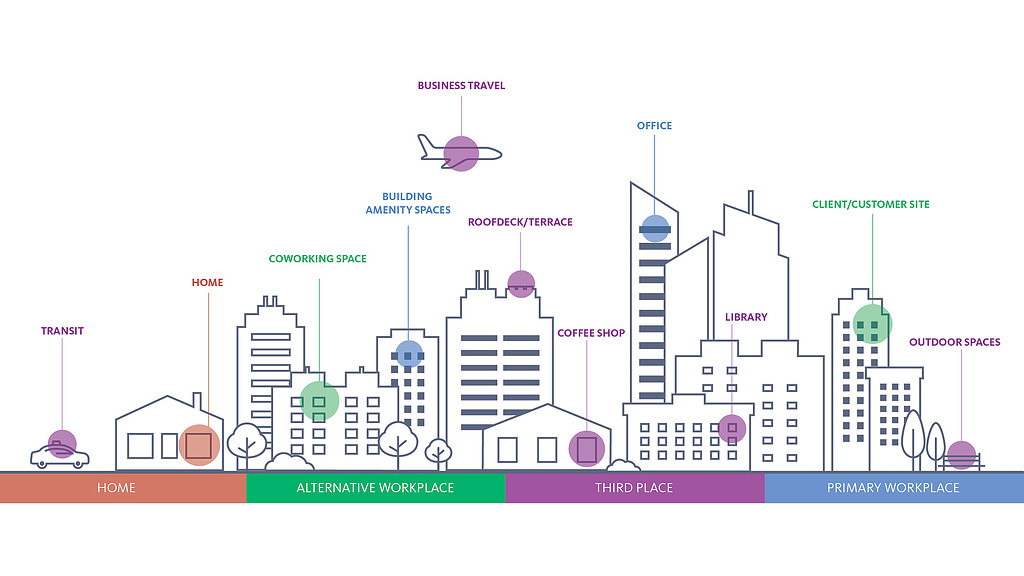Why the New Workplace Ecosystem Is Key to the Future of Work
February 24, 2022 | By Janet Pogue McLaurin
Since the pandemic began, we’ve all thought a lot about our work priorities. How do we want to spend our time? Where do we work best? How do we make more meaningful work experiences? I’ve learned that I do my most creative individual work in early mornings as I sip my coffee in the quiet of my home studio, and like to brainstorm and co-create mid-day, either in-person in the office or document share virtually. By late afternoon, I’m the least creative and that’s the perfect time to answer emails, coordinate with my team, and get organized for the next day. Thinking through how we work each day reveals how we work best, matching behaviors and experiences to the physical spaces that support and nudge us in the right ways.
As we think about the future of work, we know we’re not going back to the old ways of doing things. We have an opportunity to explore new possibilities, bringing the best of how we worked during the pandemic to work better post-pandemic. Policies, technology, and the physical workplace are tools to equip people to work better. Putting all that together, imagine a new workplace ecosystem — a Swiss Army knife approach to choosing the whole suite of places and spaces that provide the best environment for the work at hand.
Pre-pandemic, we were not in the office 100% of the time.
First, it’s important to put the “workplace ecosystem” concept into context. As much as working remotely feels like a new paradigm for many people, office workers have never really been in the office 100% of the time. At Gensler, we’ve been measuring how, when, and where we work for many years. In the U.S., the average employee spent only 81% of their time at the office in 2016; that number drops to 74% for the most innovative companies. By late 2019, innovative companies were spending more than one-third of their time working outside their primary office location. The return to the office means the workplace is the anchor of the workweek — but it doesn’t mean working in alternative locations will go away.
We expect the hybrid work model to inherit what the most innovative companies were doing before the pandemic. And we’re already starting to see this in certain global regions. While most workers continue to work remotely, we’ve studied the way that China has reopened their offices. Interestingly, Chinese office workers have returned to similar to their 2016 work patterns as well— spending about 60% of their time in the office. Globally, employees have new expectations in where they prefer to work as the home continues to be desired work setting for some work activities and the office is desired for others.
What is the office best for?
The office has a central role in the workplace ecosystem. The physical workplace is the melting pot for people to come together to work individually and do group work, and also to connect, build relationships, and establish cultural norms. The role of the office has become increasingly apparent in our research since the pandemic began. We’ve conducted 11 surveys in six countries over the course of the pandemic, and one universal truth has emerged: People rank collaboration as the #1 purpose of the office, regardless of geography, industry, role, or generation.
Top-performing companies (those recently published on Best Places to Work, Most Admired, and Most Innovative lists) prefer the office as best for both creative and ideation tasks and deep concentration. Younger workers agree. Gen Z and Millennials rank “focusing on my work” as a top reason to work in their company’s office, alongside coaching and visibility for promotion. On the other hand, senior leaders believe the physical workplace is essential to reinforce culture, be part of a community, and inspire employees toward a common purpose and vision. It also serves a vital purpose to meet with clients or customers as in-person meetings begin to happen on an increasing frequency.
The resurgence of coworking and alternative office environments.
In 2020, right before the pandemic, our research found that 18% of workers used coworking spaces as their primary office. Coworking spaces were not immune to the massive blow the pandemic dealt to offices across the county. But many leaders in the real estate community say that the outlook for coworking is optimistic. Our research suggests most executive leaders — especially among top-performing companies — will expand their real estate footprint, despite expectations of having slightly fewer people at the office at any one time. In a post-pandemic real estate shakeup, that could mean organizations opt for shorter-term or coworking locations that provide them flexibility their workers want and need. But how does coworking fit into a hybrid work future?
Looking back to our U.S. Workplace Survey 2020 report, using survey data gathered right before the pandemic began, those in coworking locations were relatively satisfied with their experiences. In fact, those in coworking locations reported higher effectiveness across all five work modes. We may be able to forecast the future of coworking by looking at the largest gaps in effectiveness — socializing and learning. Corporate campuses, developers, and tenant spaces may take cues from what coworking does best — supporting social activities/social networks and providing spaces for learning and career development.
Embrace third places — a supercharger of the work experience.
Coffee shops, libraries, parks, and other third places play a critical role in the new workplace ecosystem. Younger generations, in particular Gen Z, view third places as essential places for remote work. New college grads are used to activating and using their whole college campus for group learning, individual study, and socializing. Just as college students don’t only study in their dorm room, for younger workers, remote work doesn’t only mean working from home — it means working from anywhere.
Unlike older generations, Gen Z prefer third places for many work activities, including in-person feedback on project work and for convening unplanned meetings that often occur multiple times throughout the day. They welcome a change in venue meeting in coffee shops or parks in walkable, vibrant neighborhoods where these spaces can act as an extension of the office to attract and retain talent. Third places can also be created within an organization’s own leasehold by providing work cafes, terraces, and amenities or even leveraged with other tenants as flexible, shared spaces such as working lobbies, atriums, or outdoor spaces equipped to work. This is an opportunity for employers to provide workers autonomy and also encourage teams to optimize their time together.
The key to creating a workplace ecosystem: curate the right mix.
Autonomy is not the only element of a healthy workplace ecosystem — teams must recognize how they work best together. To unpack productivity, we must look at individual, group, and organizational levels. Much of our work lives depends on heads-down focus work, but we must also recognize how collaboration, learning, and other work activities are key to our success. In doing so, we’ll curate the right mix of in-person and virtual work.
While it’s uncertain how this will all eventually play out, we’re closely tracking market trends, and continuing to research, guide, and talk with our clients. Soon, we will have a clearer picture of how companies will manage their real estate footprints — with a possible combination of owned, leased facilities, coworking spaces, and/or hub-and-spoke regional offices. With the rise of distributed teams, virtual capabilities will be key in top companies’ real estate expansions. Organizations may gravitate to vibrant 20-minute districts to provide a rich collection of spaces as an extension of their own office environment. Through all this change, however, elements of the workplace ecosystem will provide a strong framework for how their people can embrace a hybrid future of work.
There’s no universal approach for creating an ideal workplace ecosystem as an authentic strategy for each company. In fact, it’s more complex than ever. This year, and over the next few years, we will all be experimenting, piloting, and learning. It will take the creative powers of all stakeholders — HR, IT, Strategy, Real Estate, and the C-Suite — to create compelling workplace experiences with the right balance of policy, technology, and physical space to create amazing work experiences for people. As a researcher and strategist, there has never been a better time to rethink work!
For media inquiries, email .

